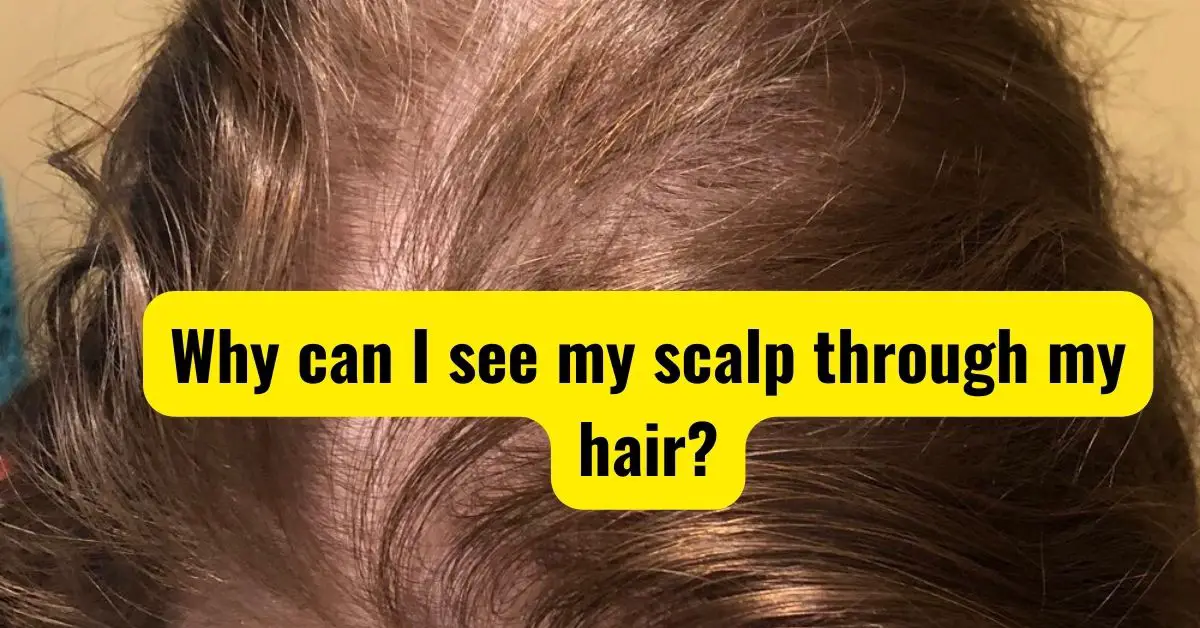Why Can I See My Scalp Through My Hair? (Helpful Answer)

It’s normal to be able to see your scalp through your hair, especially if you have fine or light-colored hair.
It’s also normal if your hair is parted or styled in a particular way. It can, however, be a sign of thinning hair.
Quick Answer: Hair thining is one of the common cause for seeing scalp through hair. And, stress, diet, vitamin deficiency, aging, and genetics are all factors to consider for thining of hair. Certain medications, hormonal imbalances Infections or illnesses, malnutrition also leads to hair thining.
Keep reading to discover more about the cause of seeing scalp through hair. Also, know how to stop hair thining and get back thick and heatlhy hair.
Why can I see my scalp through my hair?

Seeing your scalp through your hair is often indicative of thinning hair. This may be the result of a variety of factors, including dietary habits, stress levels, and vitamin deficiencies.
Diet
Your diet plays a crucial role in maintaining healthy hair. Inadequate nutrition can lead to hair thinning and loss. Hair needs vital nutrients like proteins, vitamins, and minerals to grow, so a diet lacking these components can negatively impact hair health.
Vitamin Deficiency
Vitamins like B, D, and E play a pivotal role in hair growth and health. A deficiency in these vitamins can lead to hair thinning, making the scalp more visible through the hair.
Overusing Hair Treatments and Products
Excessive use of hair treatments, such as perms, colouring, relaxers, and harsh shampoos or conditioners, can damage the hair follicles. These products often contain chemicals that weaken the hair structure and make it more susceptible to breakage.
Over time, the repeated use of these products can result in gradual hair thinning. Hair may become brittle, and the follicles may become less able to support healthy hair growth. Due to this hair fall occur.
Note: Find the difference between hair fall with white bulb and black bulb
The good news is that this type of hair thinning is usually reversible. If you stop using damaging products and adopt a more gentle hair care routine, your hair follicles can recover, and you may see an improvement in hair thickness.
Hormonal Imbalances
Hormones play a crucial role in hair growth and maintenance. Hormonal imbalances, such as those occurring during pregnancy, childbirth, or menopause in women, and age-related changes in men, can disrupt the natural hair growth cycle.
For women, during pregnancy and childbirth, hormonal fluctuations can lead to temporary hair loss. This is often referred to as postpartum hair shedding. Similarly, the hormonal changes associated with menopause can cause hair thinning in women.
In men, the hormone dihydrotestosterone (DHT) can cause hair follicles to shrink, leading to hair loss. This is often referred to as male pattern baldness and is associated with age-related hormonal changes.
Managing hormonal hair loss may require medical intervention or hormone therapy, depending on the underlying cause. Consulting a healthcare professional is essential for proper diagnosis and treatment.
Uncontrolled Stress
Stress, whether psychological (emotional) or physiological (physical), can have a profound impact on the body, including the hair. Stress triggers the release of hormones like cortisol, which can disrupt the hair growth cycle.
Psychological stress, such as work-related pressure, relationship issues, or major life changes, can lead to a condition called telogen effluvium. This condition causes a large number of hair follicles to enter the resting phase simultaneously, leading to noticeable hair thinning.
Physiological stress, such as a severe illness, surgery, or trauma, can also cause hair loss. However, this type of hair loss is often temporary and tends to resolve once the underlying stressor is addressed.
Managing stress through relaxation techniques, exercise, meditation, or therapy can help mitigate its impact on hair health. Identifying and addressing the sources of stress is crucial for preventing ongoing hair thinning.
How do I stop seeing my scalp through my hair?
If you notice your scalp through your hair, there are several steps you can take to improve your hair’s thickness and health. Here are the best advice from the dermatologist:
Maintain a Healthy Diet
Consuming a balanced diet rich in fruits and vegetables provides essential vitamins and minerals that promote hair health.
Key nutrients such as vitamins A, C, and E, as well as biotin and iron, play vital roles in hair growth and maintenance. Including protein sources like lean meats, fish, and legumes can also support strong and healthy hair.
Regular Exercise and Self-Care
Engaging in regular physical activity improves blood circulation, which is crucial for delivering nutrients to hair follicles.
Stress management through relaxation techniques, meditation, or hobbies can prevent stress-related hair loss.
Prioritize adequate sleep to support overall health, including hair growth and maintenance.
Use of Rogaine (Minoxidil)
Rogaine, a topical hair growth product, contains minoxidil, an FDA-approved ingredient for hair loss treatment.
Opt for the 5% strength version, which is commonly recommended by dermatologists for both men and women.
Apply minoxidil to the areas where your hair is thinning once or twice daily.
Be cautious not to apply it too close to your original hairline to avoid unwanted hair growth on your forehead.
Understanding Hair Growth with Minoxidil
It’s essential to understand that using minoxidil doesn’t mean your hair will fall out if you stop.
Minoxidil temporarily improves hair growth by extending the growth phase of hair follicles.
When you discontinue its use, your hair may gradually return to its natural thinning pattern due to the normal aging process.
Consult a Dermatologist
While these tips can help, consulting a dermatologist is advisable if you’re concerned about hair thinning.
Dermatologists can provide personalized advice and recommend specific treatments tailored to your unique needs.
They can also rule out any underlying medical conditions that may contribute to hair loss.
In short, addressing hair thinning involves a holistic approach, including dietary improvements, regular exercise, self-care, and the use of products like minoxidil, all while understanding the natural aging process of hair. Consulting a dermatologist ensures you receive expert guidance and personalized solutions for your specific situation.
Conclusion
In conclusion, seeing your scalp through your hair can be the result of various factors like diet, stress, and vitamin deficiency.
However, by adopting a healthy lifestyle and seeking professional advice, it’s possible to improve hair health and thickness
FAQs
Does a visible scalp mean hair loss?
A visible scalp doesn’t always indicate hair loss. It could be due to hair thinning or even the way your hair is parted.
However, if you’re noticing more scalp visibility along with other signs like excessive hair shedding, it might be indicative of hair loss.
Should I keep my hair short if it’s thinning?
Keeping your hair short can make thinning hair look fuller and more voluminous.
However, the right haircut for thinning hair can vary based on factors like hair texture and the extent of thinning. A professional stylist can recommend the best cut to suit your specific needs.
Is it normal to see scalp through hair when wet?
Yes, it’s normal to see your scalp through your hair when it’s wet. This is because water makes hair cling together, revealing more of the scalp.
Does thinning hair mean balding?
Thinning hair doesn’t necessarily mean you’re going bald. Hair thinning can be a natural part of aging or a temporary condition caused by factors like stress or diet. If hair thinning is concerning you, it’s best to consult a healthcare provider or a hair specialist for advice.
Is it normal to have thin hair?
Yes, it is completely normal to have thin hair. Hair thickness varies greatly from person to person and can be influenced by factors such as genetics, age, and overall health.

![Why is My Hair Frizzy After Shower? [Explained]](https://haircareaddiction.com/wp-content/uploads/2023/09/why-is-my-hair-frizzy-after-shower.jpg)




![Why Does Hair Grow Faster In The Summer? [Scientific Reasons]](https://haircareaddiction.com/wp-content/uploads/2023/09/why-does-hair-grow-faster-in-the-summer-768x512.jpg)